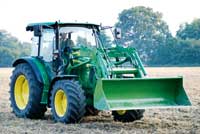Tractor test: John Deere 5100R

At first glance, the 5100R looks like a shrunk-in-the-wash version of one of the green giant’s larger tractors. And indeed, it has many of the strengths of its bigger brothers. However, the cab turns out to be fairly small.
Engine 6/10
The Deere’s 4.5-litre four cylinder uses common-rail technology but sticks with two valves per cylinder. The intercooler pack is curiously positioned directly above the engine and boasts a reversible electric fan to avoid debris build-up on the near-horizontal grille.
At rated rpm the DLG measured 83hp at the pto. Specific fuel consumption was about 2% above average at 296g/kWh. At 95hp peak power this improved, putting the 5100R bang on the average. But things got thirstier again with the six-point loading test at 313g/kWh (group average was 296g).
The engine’s constant power range put it in third place with 32%. The 46% torque rise at 30% rpm fall is acceptable. In the practical draft test the John Deere scored well: 72hp at rated rpm and 345 g/kWh. It was the strongest at peak power with 83hp, and specific consumption dropped by 7% under the 321g average.
Transmission 8/10
AutoQuad Plus brings four synchronised mechanical ratios (A – D) and four powershift steps (1 – 4), taking the total to 16F x 16R. In the key 4-12kph fieldwork range we counted eight gears. Gear-shifting has a somewhat clunky, rustic feel to it, but a new de-clutch button makes actual changes silky smooth. It’s a similar story for the four-speed powershift.
The auto function is particularly easy to use, changing according to rpm and throttle position. Change points are set by a dial which runs from an “Eco” position (early upshifts and late down changes) to “Power” (the reverse).
The gearbox isn’t perfect on the road. When you stop at a crossroads, it doesn’t drop back into the first powershift step. So you have to put it back into manual to do that and then reactivate the auto mode once you’ve set off again.
Cab 6/10
The quality of finish in the cab is immediately impressive. However the Deere’s biggest let-down is also clear from the start – there’s not enough knee-room. Even rammed right back, the seat can’t really cater for even an average-height operator.
Entry from the left is OK, as long as the steering wheel is raised. But come in from the right and the prominent loader joystick proves a bit of an obstacle.
Storage is good. The many electric connection points (optional) are useful, as are the practical paperwork holder (another extra) and the rubber containers around the seat.
For night-work there are four forward-facing spotlamps and the same again for the rear.
Cab ergonomics are impressive. Everything is in the right place to the extent that the right-hand console could compete with many multi-function armrest controls.
Out front, the JD offers good visibility. The bonnet is wasp-waisted and the transition from windscreen to glass skylight is smooth. The very high seating position and the low-set console allow good views to the sides.
However the cab ceiling slopes downwards towards the rear and this not only limits headroom but also sight to high-tipping trailers. Heating and air conditioning are within the roof-lining – there are 10 vents, but none around the feet area. At 71dB(A), the cab was the outright winner for quietness.
Hydraulics 7/10
John Deere has stuck with its tried-and-tested electronic linkage controls. This is a good decision: Rapid lift, fast-drop, sensitivity, drop-rate and lift height are all grouped neatly together.
External controls move the lower arms sharply but only a short distance before they have to be pressed again.
At 3.5t, linkage lift is just under 1t below the average of the test group (4.4 t). The arms lift 2.1t at the bottom end of the lift arc – not particularly impressive, either.
However the Deere offers the 5100R with up to three spool valves plus mid-mounts for the loader or front linkage. On our test tractor the oilflow of one double action valve could be adjusted on the control block at the back of the cab.
Adding more oil into the transmission housing means instead of the standard 10 litres, a total of 25 litres can be taken out to power hydraulic rams and motors – which still isn’t record-breaking. At 70 litres/min, pump output was under the group average (77 litres/min).
Pto 8/10
A four-speed 540, 540E, 1000 and 1000E pto is standard. The fingertip switch is OK but the pto clutch turned out to be fairly jerky. The external controls (on the left-hand mudguard only) are awkward – the system has to be activated first via another knob before the pto switch can be used. Only then can the outside controls be activated.
The 5100 R has an auto pto facility which only functions via the pre-programmable headland management system (HMS). It would be far simpler to control the pto, 4wd and diff-lock according to linkage position, we reckon.
4WD/diff-lock 6/10
The three-position 4wd switch provides an auto function too. This kicks out at 23kph and re-engages under 21kph. Similarly, the diff-lock unlocks above 12kph and when the brake pedal is used. Automatic activation is only possible via HMS.
Driving comfort 8/10
The steering wheel needs just under five turns from lock-to-lock. The steering is precise and an advantage of the short wheelbase is the extremely tight turning circle of 9.35m. But this also makes the tractor less than smooth on the road – especially with Deere’s heavy front loader. The indicators are not self-cancelling although there is a warning bleep.
For more from the tractor test click here.

